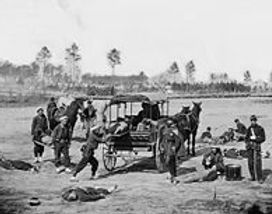
Civil War Lesson Plans

Civil War Medical Care
During the Civil War, medical care was far less advanced than today’s medicine. Few doctors caring for wounded soldiers actually knew how to treat a wound and prevent infection. In fact, doctors believed that pus was a good sign that meant a wound was healing, when it actually was a sign of infection. In the field, treatment usually ranged from inadequate to useless and often kindness was the only form of “medicine” available. During this time, sterilization was not understood and was not practiced when treating or dressing a wound. Doctors would rarely wash their hands in-between patients, especially when treating them in the field. In addition, in field hospitals it would be very rare to see doctors even rinse their surgical instruments in between operations. The lack of understanding about cleanliness and sterilization lead to many infections and eventually deaths.

Diseases also plagued the camps and claimed the lives of more men than battle wounds did. For the Union army 2 ½ deaths were caused by disease to every death caused by wounds acquired in combat. For the Confederate army their ratio was about 3 deaths due to disease for every death in combat. Army camps tended to be extremely unsanitary with large amounts of garbage and other forms of waste just lying around camp. Typhoid, pneumonia, and dysentery were some of the top diseases that killed soldiers. No one at the time knew what was causing these diseases and they had no treatment for them. Some doctors were able to link the cleanliness of the camp to the sicknesses plaguing soldiers, but germ theory was far from being understood.
Water was a large cause for many of these diseases as it would sit stagnant for long periods of time. Often latrines were dug too close to the rivers and streams where the camps would get their water supply causing their drinking water to become contaminated. Water was seen as perfectly fine to drink unless it was visibly dirty or odorous.